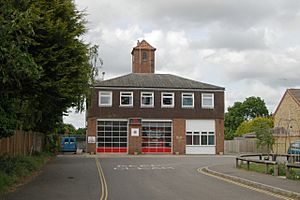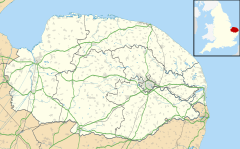Acle facts for kids
Quick facts for kids Acle |
|
|---|---|
 Acle Fire Station |
|
| Area | 9.46 km2 (3.65 sq mi) |
| Population | 2,824 (2011) |
| • Density | 299/km2 (770/sq mi) |
| OS grid reference | TG4010 |
| Civil parish |
|
| District |
|
| Shire county | |
| Region | |
| Country | England |
| Sovereign state | United Kingdom |
| Post town | NORWICH |
| Postcode district | NR13 |
| Dialling code | 01493 |
| Police | Norfolk |
| Fire | Norfolk |
| Ambulance | East of England |
| EU Parliament | East of England |
| UK Parliament |
|
Acle (pronounced AY-kuhl) is a busy market town in Norfolk, England. It's located on the River Bure, which is part of the beautiful Norfolk Broads. Acle is about halfway between the cities of Norwich and Great Yarmouth. It's special because it has the only bridge over the River Bure between Wroxham and Great Yarmouth.
The town covers an area of about 9.46 square kilometers (3.65 square miles). In 2011, about 2,824 people lived in Acle. For local government, Acle is part of the Broadland district.
The name "Acle" means "oaks lea," which describes a clearing in an oak forest. Long ago, during the time of the Tudors, many oak trees from this area were cut down. Their wood was used to build warships for Queen Elizabeth I.
Contents
Acle's Past: A Journey Through Time
Acle has a long and interesting history.
Ancient Port and Market Town
In Roman times, Acle was an important port. It was located at the end of a large river mouth called Gariensis. Acle is even mentioned in the Domesday Book, a famous survey from 1086.
In 1253, Acle was given a special permission called a "market charter." This allowed the town to hold regular markets. For many years, farmers sold their livestock and other goods here. This traditional market continued until the 1970s. Today, part of the old market area is a shop, and the other part is still a market, but mostly for tourists. No farm animals are sold there anymore.
Digging for Peat and River Life
In 1382, Acle gained the right to dig for peat. Peat is a type of soil made from decayed plants, often used as fuel. Acle still has a boatyard today, and you can enjoy walks along the River Bure to nearby places like Upton.
Roads, Railways, and Windpumps
The Acle Straight is a road that connects Acle to Great Yarmouth. It was built in 1831. Acle railway station opened in 1883 and is on the Wherry Line, which runs from Norwich to Great Yarmouth.
In 1892, a factory was built in Acle that made windpumps. These machines used wind power to drain water from the land. They even built the last windpump for the Broads here.
A bypass road for the A47, which goes around Acle, opened in 1989. However, people in the area are still asking for the Acle Straight part of the A47 to be made into a dual-carriageway. This would make the road safer, as it currently has many accidents.
Nature Walks and Local Discoveries
Since the early 2000s, local volunteers have created a walking path called Damgate. It goes from the train station to the Boat Dyke. This walk is a great place to see local plants, some of which are quite rare. People have also often seen a kingfisher on this walk, which locals call Henry.
Between 2009 and 2014, archaeologists dug test pits in the village. They found interesting things about Acle's past, and a report about their discoveries was published in 2017.
Acle also has a high school called Acle Academy.
St Edmund's Church: A Historic Building
The church of St Edmund in Acle is one of 124 churches in Norfolk that have a special round tower.
The Oldest Parts of the Church
The round part of the tower is the oldest section of the church. Experts believe it was built by the Saxons between 850 and 950 AD. The eight-sided (octagonal) part of the tower was added later, in the 13th century. The top parts, called battlements, were added in 1472.
Inside the tower are six bells. Five of these bells were made in Norwich in 1623. A metal frame helps keep the tower strong so the bells can be rung safely.
Entering the Church
You enter the church through a porch on the north side. This porch was built in 1495. The walls of the church are mostly made of rough stones, but the porch uses carefully shaped flint stones, which look different.
The main part of the church, called the nave, is thought to be from the Norman period. This is because of its size and the thickness of its walls. However, you won't see any original Norman doorways or arches today. In 1927, during repairs, some Norman stones were found hidden in a wall. It's likely that the original Norman doorways were removed when the floor was raised in the 13th century, perhaps to stop flooding.
The main windows in the nave are from the 14th century. One window near the pulpit is from the Tudor period. Long ago, the church walls were probably painted. You can still see a tiny piece of a painting of a dragon or snake on one wall. The stone font in the nave, where baptisms take place, is from 1410.
The Chancel and Screen
A wooden screen from the 15th century separates the nave from the chancel. The chancel is the part of the church where the altar is. This screen was not originally made for Acle church. It might have come from another old building like St Benet's Abbey. The chancel itself is from the 14th century. Its windows are also from the 14th century, except for the large east window, which has colorful Victorian stained glass.
Images for kids
See also
 In Spanish: Acle para niños
In Spanish: Acle para niños




